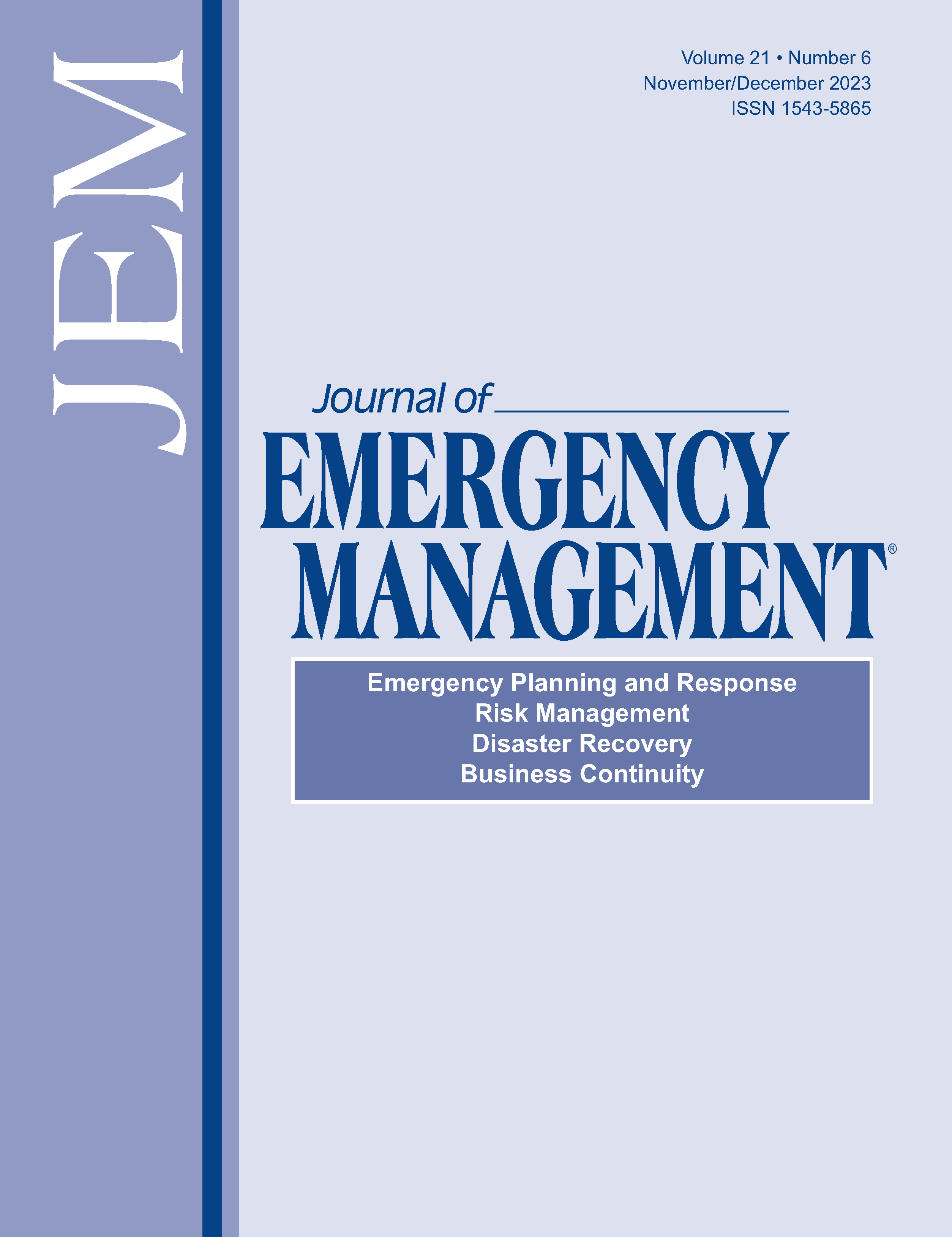Community Assessment for Public Health Emergency Response (CASPER) following Hurricane Michael: Gadsden, Calhoun, and Jackson Counties, Florida, 2020
DOI:
https://doi.org/10.5055/jem.0810Keywords:
hurricane, Hurricane Michael, disaster preparedness, disaster response, community assessment, mental health, rural healthAbstract
Objectives: To assess community preparedness and ongoing recovery efforts in the rural counties most severely impacted by Hurricane Michael, including structural and economic losses, injury and illness, healthcare access, and suicide risk and ideation. Design: The Florida Department of Health conducted a Community Assessment for Public Health Emergency Response (CASPER) in January 2020, 15 months after Hurricane Michael made landfall in October 2018.
Setting: A total of 30 clusters were randomly selected from three rural counties in the Panhandle of Florida, including Jackson (15 clusters), Gadsden (11), and Calhoun (four) counties.
Participants: A total of 185 face-to-face and two phone interviews were conducted with residents 18 years of age or older.
Main outcome measure: Hurricane preparedness, structural and economic losses, access to care, and physical and mental health.
Results: Around 43 percent of respondents evacuated as a result of Hurricane Michael, and at least two-thirds of all respondents reported having an emergency supply kit and enough nonperishable food, water, and medication. Structural damage was extensive with 63 percent reporting home damage, averaging over $32,000. Few injuries or illnesses were reported post-landfall (9 percent), with the most common being minor injuries and bacterial infections. Most respondents reported continued access to healthcare if needed. The most common stress-related issues reported were difficulty sleeping (19 percent) and agitated behaviors (10 percent). Seven percent of respondents reported being at moderate to high risk for suicide.
Conclusions: Rural areas may lack resources, such as healthcare facilities, skilled workers, and supplies, that hinder their ability to recover from storms when compared to more urban counties. Many residents reported that 15 months after the storm, their homes were still not fully repaired. A majority of residents were prepared with adequate supplies, had minimal disruption in employment or healthcare access, and had few illnesses or injuries during the storm or the recovery efforts.
References
National Oceanic and Atmospheric Administration: Hurricane Michael Upgraded to a Category 5 at Time of US Landfall—Post-Storm Analysis Estimates Sustained Winds of 160 mph. Washington, DC: US Department of Commerce, 2019.
Beven JL, Berg R, Hagen A: National Hurricane Center Tropical Cyclone Report. Hurricane Michael. Washington, DC: National Oceanic and Atmospheric Administration, Commerce, 2019.
National Oceanic Atmospheric Association: Historical hurricane tracks. Available at https://coast.noaa.gov/hurricanes. Accessed August 2020.
National Oceanic and Atmospheric Administration: Catastrophic Hurricane Michael strikes Florida Panhandle. Available at https://www.weather.gov/tae/HurricaneMichael2018. Accessed October 10, 2018.
Torres-Mendoza Y, Kerr A, Schnall AH, et al.: Community assessment for mental and physical health effects after Hurricane Irma—Florida keys, May 2019. MMWR Morb Mortal Wkly Rep. 2021; 70(26): 937-941.
Rodriguez E, Duclos C, Joiner J, et al.: Community assessment for public health emergency response (CASPER) following hurricane Michael, Bay and Gulf counties, Florida, 2019. J Public Health Manag Practice. 2022; 28: E542-E551.
Florida Legislature: The 2020 Florida Statutes. Chapter 288: Commercial Development and Capital Improvement. 2020. Available at http://www.leg.state.fl.us/Statutes/index.cfm?App_mode=Display_Statute&URL=0200-0299/0288/Sections/0288.0656.html. Accessed September 12, 2023.
US Census Bureau QuickFacts: Jackson County, Florida; Gadsden County, Florida; Calhoun County, Florida; United States. Available at https://www.census.gov/quickfacts/fact/table/jacksoncountyflorida,gadsdencountyflorida,calhouncountyflorida,US/PST045219. Accessed June 2021.
FLHealthCharts: Individuals Below 200% of Poverty Level. Tallahassee, FL: Florida Department of Health, Division of Public Health Statistics, & Performance Management, 2021.
State Emergency Response Team: Statewide Public Health and Medical (ESF8) Situation Report-Hurricane Michael. 2018.
Centers for Disease Control and Prevention: Community Assessment for Public Health Emergency Response (CASPER) Toolkit. 3rd ed. Atlanta, GA: Centers for Disease Control and Prevention, 2019.
Osman A, Bagge CL, Gutierrez PM, et al.: The Suicidal Behaviors Questionnaire-Revised (SBQ-R): Validation with clinical and nonclinical samples. Assessment. 2001; 8(4): 443-454.
Psychological Scales: The Suicide Behaviors Questionnaire- Revised (SBQ-R). Available at https://scales.arabpsychology.com/s/the-suicide-behaviors-questionnaire-revised-sbq-r/. Accessed September 15, 2020.
Ceballos A: Mental health aid bolstered by telehealth in counties hard-hit by Hurricane Michael. Tallahassee Democrat. 2019.
Centers for Disease Control and Prevention: CDC/ATSDR Social Vulnerability Index. Atlanta, GA: Centers for Disease Control and Prevention. Available at https://www.atsdr.cdc.gov/placeandhealth/svi/index.html. Accessed June 21, 2021.
Emrich CT, Morath DP, Bowser GC, et al.: Climate-Sensitive Hazards in Florida: Identifying and Prioritizing Threats to Build Resilience against Climate Effects. Columbia, SC: Hazards and Vulnerability Research Institute, 2014.
Pan K, Beitsch L, Gonsoroski E, et al.: Effects of Hurricane Michael on access to care for pregnant women and associated pregnancy outcomes. Int J Environ Res Public Health. 2021; 18(2): 390. DOI: 10.3390/ijerph18020390.
Clarke TC, Schiller JS, Boersma P: Early Release of Selected Estimates Based on Data from the 2019 National Health Interview Survey. Atlanta, GA: National Center for Health Statistics, 2020.
Centers for Disease Control and Prevention: Suicide Prevention. Atlanta, GA: Centers for Disease Control and Prevention, National Center for Injury Prevention and Control, 2022.
Fitzpatrick KM, Spialek ML: Suicide ideation and a post-disaster assessment of risk and protective factors among Hurricane Harvey survivors. J Affect Disord. 2020; 277: 681-687.
WTXL Digital Staff: Area communities impacted by Hurricane Michael awarded funding from State of Florida. WTXL Tallahassee. 2022. Available at https://www.wtxl.com/news/florida-news/area-communities-impacted-by-hurricane-michael-awarded-funding-from-state-of-florida. Accessed February 14, 2022.
Hamideh S, Peacock WG, Van Zandt S: Housing type matters for pace of recovery: Evidence from Hurricane Ike. Int J Disaster Risk Reduct. 2021; 57: 102149-1049.
Wilson B, Tate E, Emrich CT: Flood recovery outcomes and disaster assistance barriers for vulnerable populations. Front Water. 2021; 3: 1-15.
Published
How to Cite
Issue
Section
License
Copyright 2007-2025, Weston Medical Publishing, LLC and Journal of Emergency Management. All Rights Reserved.






